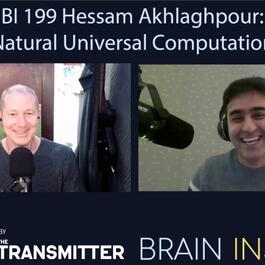
Support the show to get full episodes, full archive, and join the Discord community. The Transmitter is an online publication that aims to deliver useful information, insights and tools to build bridges across neuroscience and advance research. Visit thetransmitter.org to explore the latest neuroscience news and perspectives, written by journalists and scientists. Read more about our partnership. Sign up for the “Brain Inspired” email alerts to be notified every time a new “Brain Inspired” episode is released: https://www.thetransmitter.org/newsletters/ To explore more neuroscience news and perspectives, visit thetransmitter.org. Hessam Akhlaghpour is a postdoctoral researcher at Rockefeller University in the Maimon lab. His experimental work is in fly neuroscience mostly studying spatial memories in fruit flies. However, we are going to be talking about a different (although somewhat related) side of his postdoctoral research. This aspect of his work involves theoretical explorations of molecular computation, which are deeply inspired by Randy Gallistel and Adam King's book Memory and the Computational Brain. Randy has been on the podcast before to discuss his ideas that memory needs to be stored in something more stable than the synapses between neurons, and how that something could be genetic material like RNA. When Hessam read this book, he was re-inspired to think of the brain the way he used to think of it before experimental neuroscience challenged his views. It re-inspired him to think of the brain as a computational system. But it also led to what we discuss today, the idea that RNA has the capacity for universal computation, and Hessam's development of how that might happen. So we discuss that background and story, why universal computation has been discovered in organisms yet since surely evolution has stumbled upon it, and how RNA might and combinatory logic could implement universal computation in nature. Hessam's website. Maimon Lab. Twitter: @theHessam. Related papers An RNA-based theory of natural universal computation. The molecular memory code and synaptic plasticity: a synthesis. Lifelong persistence of nuclear RNAs in the mouse brain. Cris Moore's conjecture #5 in this 1998 paper. (The Gallistel book): Memory and the Computational Brain: Why Cognitive Science Will Transform Neuroscience. Related episodes BI 126 Randy Gallistel: Where Is the Engram? BI 172 David Glanzman: Memory All The Way Down Read the transcript. 0:00 - Intro 4:44 - Hessam's background 11:50 - Randy Gallistel's book 14:43 - Information in the brain 17:51 - Hessam's turn to universal computation 35:30 - AI and universal computation 40:09 - Universal computation to solve intelligence 44:22 - Connecting sub and super molecular 50:10 - Junk DNA 56:42 - Genetic material for coding 1:06:37 - RNA and combinatory logic 1:35:14 - Outlook 1:42:11 - Reflecting on the molecular worldSupport the show to get full episodes, full archive, and join the Discord community. The Transmitter is an online publication that aims to deliver useful information, insights and tools to build bridges across neuroscience and advance research. Visit thetransmitter.org to explore the latest neuroscience news and perspectives, written by journalists and scientists. Read more about our partnership. Sign up for the “Brain Inspired” email alerts to be notified every time a new “Brain Inspired” episode is released: https://www.thetransmitter.org/newsletters/ To explore more neuroscience news and perspectives, visit thetransmitter.org. Hessam Akhlaghpour is a postdoctoral researcher at Rockefeller University in the Maimon lab. His experimental work is in fly neuroscience mostly studying spatial memories in fruit flies. However, we are going to be talking about a different (although somewhat related) side of his postdoctoral research. This aspect of his work involves t
From "Brain Inspired"


Comments
Add comment Feedback